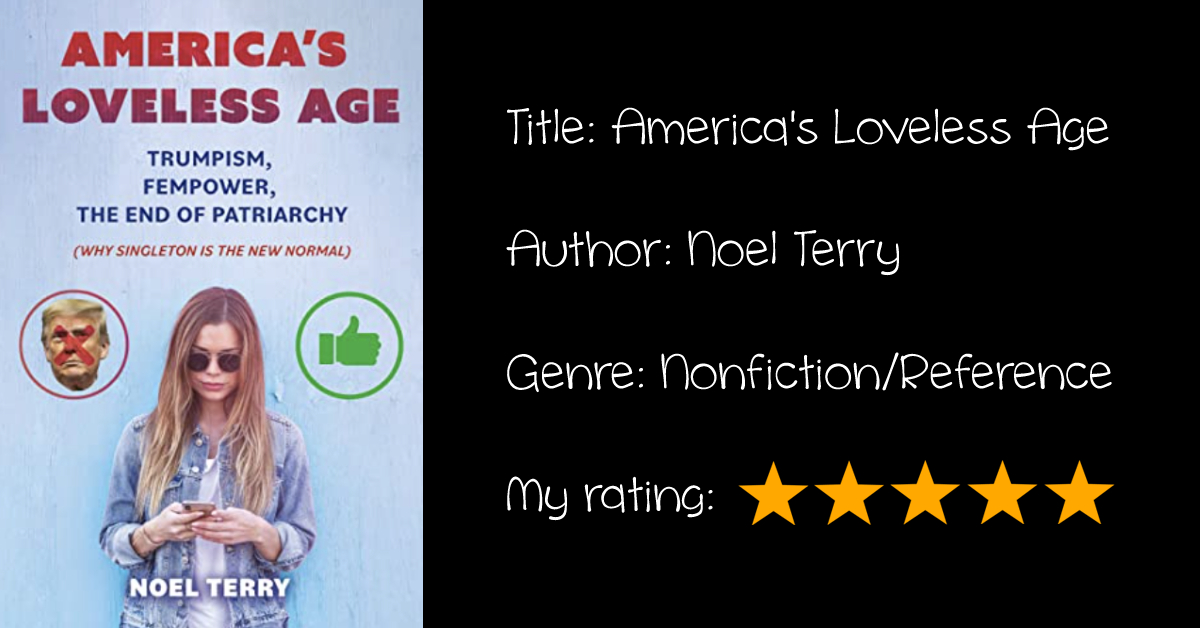Review: “America’s Loveless Age: Trumpism, FemPower, the End of Patriarchy: (Why Singleton is the New Normal)”
This book came to me via an ARC program and it sounded intriguing — I’d never thought of the correlation between politics and the dating scene in such a way!
The Premise
This non-fiction book examines the influence of the U.S.A.’s president 45th president, Donald Trump, on the divisive “loveless age” whereby marriage rates fell, women’s rights were impacted, and the very fabric of our society became fractured. From racism to misogyny to patriotism and the erratic highs and lows of unchecked power, it examines gender dynamics and mating conventions that form part of Trump’s contentious legacy.
The Pros & Cons
Never before has politics influenced our love lives this intimately. As Donald Trump climbed into power, Trumpism swept over the U.S.A. and swiftly divided the population. From the blatant misogyny to intellectual incompetence to questionable practices that plague his character as a leader, his candidacy began as a joke to many — until his win suddenly became no laughing matter.
This book is unique in its exploration of “mating politics” that bleeds into everything else in our society — as the author reminds us, romance and marriage are the “conduit to family formation, the bedrock of society.”
Trump’s legacy was one of divisiveness in many arenas, and this is an important factor that isn’t often considered by historians. But as the author states:
“When politics interferes with love, you sense the country is too painfully divided.”
The wave of Trumpism saw politics becoming personal. Dating apps even used Trump-related questions in compatibility surveys, and profiles often clearly indicated a political stance — for instance, women anticipated that their career prospects would be slim under a Trump presidency, and avoided dating his supporters with profile statements like “No Trumpers please.” As one dating site stated: “It’s truly unprecedented the change in how people are using politics as a signal in dating, a reflection of the polarization under Trump and the rage of his detractors—particularly women.”
Packed with factual research, the book deep-dives into Trump from the ground up: the making of the man; the people who supported his rise to power despite blusters along the campaign trail that included mocking a disabled reporter and a distinguished Vietnam POW, and the infamous “grabbing women by the pussy” debacle. It is highlighted that women put Trump in power, voting not only for the misogynistic bully but also against the perceived brand of feminism that Hillary Clinton represented because, as one woman termed it: “I simply prefer the leadership of a strong male.”
The author posits the uncomfortable truth:
Did (white) women really vote for the least qualified candidate in U.S. history—a billionaire from the plutocracy class pretending to be a populist (a pluto-populist)—or were they voting against a “snobocrat” class, an elite feminism pretending to be populist for ordinary women?
The book points out Trump’s political failings: a fast-churning White House staff plagued with frequent resignations, racking up trillions in national debt, numerous proven false claims (over 30,500 over 4 years!), his poor handling of the Coronavirus pandemic, looting the taxpayer purse in record defense/border wall spending, spitefully repealing all of Obama’s achievements — including the virus unit whose purpose was to address global pandemics, and many more. He also demonstrated blatant white nationalism and racism, and his gender beliefs were telling: there were only 4 women initially appointed out of 24 Cabinet positions.
The author reiterates that Trump’s “diehard traditionalism” of “making America great again” hinged on America’s golden age of patriarchal glory, when “women and minorities knew their place and power was preserved for white men.”
It is a sobering thought that tens of millions of people put Trump into power, and despite all his failings, years later he still has so many followers who support him unfailingly — so much so, that he was able to incite thousands of people to attack the Capitol Building to prevent a peaceful transfer of power to Biden.
From his own government to the laws he created or beliefs he supported, Trump’s legacy is his control of the cultural narrative as he recreated the U.S.A. in his own image — and that image is a frightening reality that we have yet to truly escape.
Conclusion
This non-fiction book is a lot to unpack, and blends a wide range of sources throughout almost every sentence. Well researched and put together, it is a tell-all tale that gives a much deeper perspective than the average person’s media consumption may provide. It covers all the intricacies of contemporary news and current affairs relating to Trump and the reverberations in society that emerged as a result of his influence. Note: it is a “heavy” read, and provides a thoroughly comprehensive overview; you will need to take your time with it to fully appreciate the amount of work compiled into this. It was very educational and analytical, and I learnt a lot that will stay with me. I highly recommend to other adult readers who want to be politically enlightened.








